The Future of Black Holes
by
Jessica Krall & Jessica Felhofer
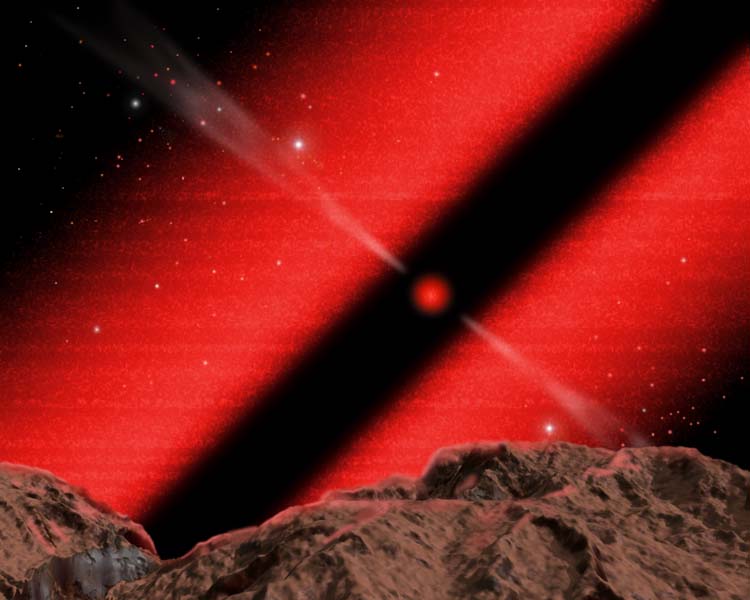
The name 'black hole' was invented by John Archibald Wheeler. But do black holes really exist? Scientists and astronomers alike have found conclusive evidence throughout history that black holes do exist. It is a described as a single point in space with infinite mass where gravity distorts the space-time surrounding it so much that not even light can escape. Through looking at the history, present technology and breakthroughs in the field of black holes, we can predict what future research in this field will yield.
In 1687, Isaac Newton's theory of gravity was published. His theory explained the relationship between the escape velocity and the mass of a star. Newton believed that when a star has a large mass and is compact, then a large escape velocity is needed to overcome the star's gravitational pull. On the other hand, if the star has less mass, then a smaller magnitude of velocity is needed to overcome the gravitational pull (Kaku 1994). In 1783, John Michell observed that if a star has enough mass and is dense enough, then light would not even escape—that is, the escape velocity would be greater than the speed of light. He calculated the mass to be ten million times heavier than the sun. Michell even predicted that if this dense object was orbiting around a companion star, it could be detected even if we could not see it (Barrow 1983).
It was not until 1915 when his idea was taken seriously. In that year, Einstein published his now-famous theory of general relativity. His theory consists of 10 different equations that can be used to predict the degree of curvature of space-time. His equations are based on the amount of mass present and the distribution of mass in space. Objects, including light, follow this curvature as they travel. But in some places, space-time is so curved due to a massive, compact object that absolutely nothing can escape (Dauber 1996). The curve is a circle here. Everything in it circulates in hypersphere. This strange piece of space-time is disconnected from the space-time surrounding it (Kaku 1994).
The difference between Newton's theory and Einstein's is that Newton's theory only applies to weak gravitational fields. Einstein's theory can be applied to intense gravitational fields, even black holes. Another difference is that Newton's theory of gravity includes only one simple equation as opposed to Einstein's 10 complicated equations (Barrow 1983).
A few months after Einstein's theory was published, Karl Schwarzschild used the equations to calculate the gravity around a massive, stationary sphere. There is a border surrounding the sphere where no light, or any other object, can escape. If light approaches this boundary close enough, it is bent and spirals into the mass in the center. This event horizon lies at the Schwarzschild radius (Fraser 1995). When something reaches this point, there is no possibility of escape. Schwarzschild's solution was the precise description of the phenomenon envisioned by Michell more than one century before.
A man named Roy Kerr would later use Einstein's equations to calculate the gravitational field of a massive body, but this time take rotation of the body into account.
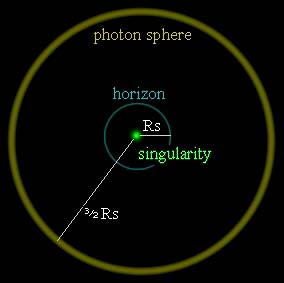
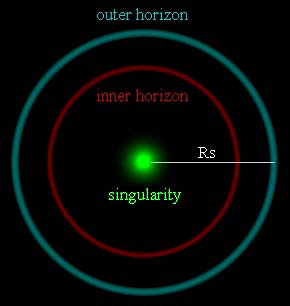
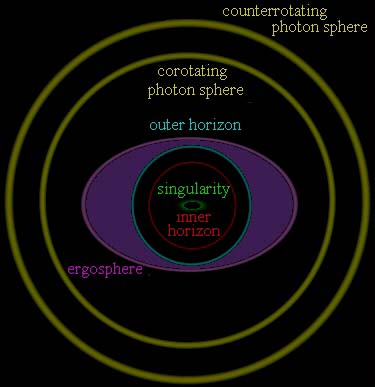
When supermassive stars die, a supernova explosion may occur. The explosion is caused by the imbalance between the pressure of gravity and fusion. Nuclear fusion causes pressure to push outward from the star. Gravity is what keeps the star together, though. When the star runs out of nuclear fuel, the force of fusion is no longer there to repel the force of gravity, so the star collapses (Kaku 1994). Two products are possible—a neutron star or a black hole.
If the mass of the core of the exploded star is between 1.4 and 3 times larger than our sun, it becomes a neutron star. In these stars, the gravity is so immense that electrons in the atoms of the star are pushed into the nucleus. These electrons fuse with protons and become neutrons. The result is an extremely dense and compact star made up of neutrons (Gutch 1998).
If the mass of the core of the exploded star is more than three times our sun's mass, gravity pulls the matter together past the neutron stage. The star continues to collapse until it is a single point (Ronan 1994). The point has absolutely no volume and infinite density. This is the singularity—the center of a black hole (Hathaway 1995).
There are only three properties that black holes have—total mass, net electric charge, and total angular momentum. There are four types of black holes. One is a Schwarzschild black hole. This has no charge and no angular momentum. A Reissner-Nordstrom black hole has charge but no angular momentum. A Kerr black hole has angular momentum and no charge. A Kerr-Newman black hole has charge and angular momentum. All of the black holes are named after mathematicians who solved Einstein's equations in his theory of general relativity.
Schwarzschild's black hole is the simplest model, neutral and stationary, so it is often used. Kerr's model is the most applicable though, because real black holes rotate and have no charge (Illingworth 1994).
Everything that enters the black hole will end up at the singularity. However much mass is in the singularity determines how big the black hole is. Black holes can be small, formed only from one star, or they can be supermassive, like at the center of galaxies. (Supermassive black holes form during the formation of a galaxy when stars crowd in the central core and collapse.)
We measure black hole sizes by referring to the size of the event horizons, which depends on the mass at the singularity. If the mass inside is small, then gravity has effect only on a small amount of space surrounding the singularity. If the mass is large, gravity will expand its reaches farther into the space surrounding the singularity (Melton 1994). If a galaxy had a black hole at the center with a mass of several hundred million stars, the event horizon would be the width of our solar system. If the sun became a black hole, its event horizon would have a radius of only 3 kilometers. If the earth were crushed into a single point, its event horizon would be the size of a marble (Ronan 1994).
The event horizon of a black hole is a one way membrane. Once something crosses it, there is no way to get out unless it can travel faster than the speed of light. Everything that is trapped by a black hole is not visible from the outside. As more mass gets trapped in the black hole, the event horizon expands (Fraser 1995).
When Roy Kerr produced his model of a black hole and considered rotation, his model was slightly different than Schwarzschild's model. The hole's rotation around an axis caused the singularity to be in the shape of a ring instead of a point (McManus 1988).
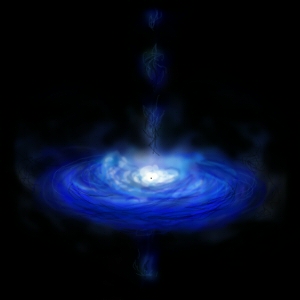
A rotating black hole most likely has an accretion disk: a sheet of matter that is perpendicular to the axis, which the black hole rotates around. Matter that is attracted by the gravity of a black hole gets piled up around other matter waiting to fall into the black hole. On the outer edges of this disk, matter rotates more slowly than matter near the center. The matter moves in tightening spirals toward the singularity.
As particles spiral in the accretion disk, they collide. The kinetic energy of the particles is then turned into heat. The temperature can reach hundreds of thousands and even millions of degrees. The energy is so high at these accretions disks that X rays are emitted.
The X rays emitted outside the event horizons escape and can be detected by astronomers. In the galaxy of NGC 4261, the Hubble Space Telescope has photographed an accretion disk spinning around a high-gravity object that cannot be seen—a possible black hole (Goldsmith 1991).
Black holes are also suspects in binary systems where a large star rotates around an unseen object, such as the binary system of V616 Monocerotis. The unseen object must have an incredible amount of mass since such a massive star is lured into orbiting it. The dark object is, again, possibly a black hole (Bunch 1996).
In some binary systems, the black hole and the companion star are close enough for matter from the companion star to transfer to the black hole. The matter does not fall directly into it, though. Because the stars are rotating, the matter forms an accretion disk around the black hole. The accretion disk emits detectable X rays. This is the situation of the binary system Cygnus X-1. This supergiant star is accompanied by a massive dark object. This possible black hole has an accretion disk that emits X rays. The same thing is happening in the binaries in LMC X-3 (in the Large Magellanic Cloud), V404 Cygni, and SS433 in the constellation of Aquila the Eagle. In the Great Annihilator, another binary system in the Sagittarius constellation, the transfer of matter from the star to the dark companion raises temperatures to 2 billion degrees Fahrenheit and emits gamma rays (Bunch 1996).
There may be giant black holes in the centers of galaxies also. By measuring the velocity of dust clouds that orbit the middle of galaxies, astronomers can determine the amount of mass in the center where they expect the black holes to be. In the center if the Messier 87 Galaxy, they have calculated the mass of a black hole to be 2.4 times the sun's mass. There is a black hole with a mass of 40 million times the mass of the sun in the center of the NGC 4258 galaxy. An even larger mass of 1.2 billion times the sun's mass was discovered in the elliptical galaxy of NGC 4261. There have been numerous other observations of massive black holes in the centers of galaxies. This copious quantity of evidence shows that black holes not only exist, but that they are quite common (Bunch 1996).
Stephen Hawking, author of A Brief History of Time, once said, “Which came first, the chicken of the egg? Did the universe have a beginning, and if so, what happened before then? Where did the universe come from, and where is it going?” Although the future for black holes is quite unknown, we truly believe through further knowledge of black holes we will be able to find out how our universe began and how it will end. Many theories of the beginning of the universe exist, including the Big Bang theory, but with further research of black holes we might be able to discover just how the universe did begin. With that same knowledge, we can possibly determine how our universe will end. (Hawking 1996).
On a more exciting side of the future of black holes, wormholes and the possibility of time travel would change the universe we know today. The idea of wormholes first came from the idea of white holes. The equations of general relativity have an interesting mathematical property: they are symmetric in time. This means that you can take any solution to the equations and imagine that time flows backwards rather than forwards, and you will get another valid solution to the equations. If you apply this rule to the solution that describes black holes, you receive a white hole. Since a black hole is a region of space from which nothing can escape, the time-reversed version of a black hole is a region of space into which nothing can fall. So, just as a black hole sucks things in after they pass the event horizon, a white hole would spit these things out. (Hawking 1996). Then comes the wormhole. The wormhole is thought to be the combination of a black hole and a white hole. So rather than spitting something out or sucking something in, the wormhole would actually move something to a different place or time. Unfortunately, wormholes are more science fiction than they are science fact. A wormhole is a theoretical opening in space-time that one could use to travel to far away places very quickly (Hawking 1996). Time travel could result from discoveries of wormholes. Yet, it has never been proven that wormholes exist and there is no experimental evidence for them, but it is fun to think about the possibilities their existence might create.
If the further research to black holes leads to information surrounding the beginning and the end of our universe, it will have a dramatic effect on the world today. First, we will be able to tell if the universe will end and than we could apply this knowledge. This information would potentially be important because then we can perhaps take preventive measures to help the universe from ending.
Wormholes and the possibility of time travel would also have vast consequences on modern-day society. The entire history of our universe could be changed through these discoveries. But first, we would have to find wormholes and exploit their powers in order to effectively travel through time. Even if we manage to do this, we would still have no control over where or when we would arrive when we left the wormhole. This is one of the most sketchy theories for the future of black holes, but also one of the most interesting because it has the power of changing the universe we know today.
Bibliography
Barnes-Svarney, Patricia, ed. Science Desk Reference. New York: The
Stonesong Press, Inc., 1995.
Barrow, John D., and Joseph Silk. The Left Hand of Creation. New York:
Oxford University Press, 1983.
Bornack, Jillian. “Black Hole Pictures.” Jillian's Guide to Black Holes.
http://www.phy.syr.edu/courses/PHY312.98Spring/projects/jebornak.
Internet. 1 Jan 2001.
Bunch, Bryan. Handbook of Current Science and Technology. Detroit:
Gale, 1996.
Burnham, Robert, et. al. Advanced Skywatching. San Francisco: Time Life
Books, 1997.
Dauber, Philip M. and Richard A. Muller. The Three Big Bangs. Reading,
MA: Addison-Wesley Publishing Company, 1996.
Ferguson, Kitty. Prisons of Light. New York: Cambridge University Press,
1996.
Flowers, Charles. A Science Odyssey. New York: William Morrow and
Company, Inc., 1998.
Fraser, Gordon. The Search for Infinity. New York: Facts on File, 1995.
Gitlin, J. “Black Hole Pictures.” HST's Greatest Hits 1990-1995.
http://oposite.stsci.edu/pubinfo/BestOfHST95.html. Internet. 1 Jan 2001.
Goldsmith, Donald. The Astronomers. New York: St. Martin's Press, 1991.
Gribbin, John. Unveiling the Edge of Time. New York: Harmony Books,
1992.
Gutch, William A. 1001 Things Everyone Should Know About the Universe.
New York: Doubleday, 1998.
Hathaway, Nancy. The Friendly Guide to the Universe. New York:
Penguin Books USA Inc., 1995.
Hawking, Stephen. A Brief History of Time. New York: Bantam Books, 1996.
Hoskin, Michael. The Cambridge Illustrated History of Astronomy. New
York: Cambridge University Press, 1997.
Illingworth, Valerie, ed. The Facts on File Dictionary of Astronomy. New
York: Facts on File, 1994.
Kaku, Michio. Hyperspace. New York: Oxford University Press, 1994.
McManus, Jason, et. al. Stars. Alexandria, VA: Time Life Books, 1988.
Melton, Melanie. Will Black Holes Devour Our Universe?. Waukesha, WI:
Kalmbach Publishing Co., 1994.
Rees, Martin. Before the Beginning. Reading, MA: Addison-Wesley, 1997.
Ronan, Colin A. The Universe Explained. New York: Henry Holt and
Company, 1994.
Taylor, John. When the Clock Struck Zero. New York: J.G. Taylor
Consultants Ltd., 1993.
Travers, Bridget, ed. World of Scientific Discovery. Detroit: Gale Research,
1994.
Tucker, Wallace and Karen. The Dark Matter. New York: William Morrow
and Company, Inc., 1988.